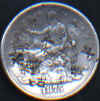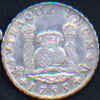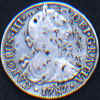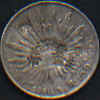Foreign Silver Coins
I. Foreign
Silver Coins As "Quasi Sycee"
From the later part of the 16th century until the early 20th century, tremendous numbers of a wide variety of foreign silver coins
circulated throughout China. The more important were Spanish colonial Cobs and
Pillar Dollars, Dutch Ducatons and Mexican Eagle
Dollars. Countless pieces were
chopmarked. A frequently asked question is: Why did Chinese chop those coins?
Three Major Foreign Silver Coins Circulated in China Before 1800
When foreign silver coins came into China 4 centuries ago, the Chinese believed they were a kind of silver ingot, and evaluated them by weight and silver content, not by face value. They weighed every sycee, and silver coins- a "quasi sycee" - weighed them with scales and assayed their purity by their experience and eyesight, chops and even chisels. Chopping, a part of Chinese daily life in dealing with all their measured currencies, was not just aiming at silver coins, but also used with sycee.
II. Chop to identify, guarantee, assay and authenticate
Chinese chopmarked foreign silver coins to:
-
Identify the payers who handed out the coin as payment. The payers, most of the time a merchant or local bank, used their chopmarks as a symbol of assayed or testified fineness.
-
Guarantee the fineness of the coins by the merchant or local bank who chopped.
-
Assay the coin for its silver fineness and authenticate it by deep chopping, drilling or other destructive means to look inside of the coin, in order to assure the consistency of its quality.
Chopmarks relating to 1 and 2 above, were a way for Chinese businessmen to give warranty to their customers. Many of them were pressed onto the coins, in a clear, but not in a harmful way. For the purpose of easy recognition and to avoid the counterfeiting of their chopmarks. Some of the merchants created their own secret codes, symbols or characters for chopmarking. Among them, Combined Characters were the most distinctive kind. A Combined Character was created by two or more Chinese characters, and the meaning of those multiple characters was expressed in the combination. Many of them were difficult to understand, even for the scholars in nowadays and this was one of the ways how Chinese conventional merchants kept their commercial activities confidential.
Examples on the combined characters
 A combination of 4
characters-人 Zen 人 Zen 吉 Ji 祥 Hsiang (Luck to Everybody)
A combination of 4
characters-人 Zen 人 Zen 吉 Ji 祥 Hsiang (Luck to Everybody)
 A combination of 2 characters
人 Zen (People) and 來 Lai (Come), together, as "the comer", which implies from whom the coin was received.
A combination of 2 characters
人 Zen (People) and 來 Lai (Come), together, as "the comer", which implies from whom the coin was received.
 A combination of 3 characters-
二 Er (Two), 六 Lio (Six), 來 Lai (Come), together, as "Received as a silver with a
premium of 2.6 taels on each 50 taels")
A combination of 3 characters-
二 Er (Two), 六 Lio (Six), 來 Lai (Come), together, as "Received as a silver with a
premium of 2.6 taels on each 50 taels")
III. Heavily chopmarked
Milled silver coins were a brand new experience to Chinese, and their expertise in authenticating silver sycee did not extend to modern circular coinage. When first learning to use this fancy silver currency, many Chinese were cheated by counterfeits with low silver content, such as silver plated copper, or in many cases, hollowed out silver coins refilled with base metal such as lead.
As time went on, the forgery of foreign silver coins in China never ctopped. On the contrary, counterfeiting techniques continuously improved and evolved, the only thing which remained unchanged was the inferior purity of the counterfeited coins, and the loss borne by people when mistakenly received them. The Chinese learned lessons from the mistakes they made, and merchants coached their pupils and employees to always authenticate foreign silver coins in the most rigid way. Since even a coin bearing chopmarks could be a fake, they had to rely on their own eyes and chops, and as a result, the silver coins were repeatedly and heavily chopped. Many fake- detecting skills were exchanged among the merchants, and these were passed from one generation to another. Publications on authenticating foreign coins became "must-reads" for all Chinese.
2 booklets dated the 4th Year of Tong Ze (1865) and the 23rd year of Kuang Hsu (1897) respectively, on the subject of authentication of Mexican Eagle Dollars and Spanish colonial Pillar Dollars.
IV. Less chopmarks on sycee
Chinese also chopped, holed, cut and used many torturous means to find out the fineness of their sycee, but in general, sycee were less chopmarked than silver coins. Why?
Before foreign silver coins came into existence, sycee in China had been circulated for more than 1,000 years and a purity assurance system had already been created. Such a system was usually reliable for the Chinese; they only had to chop sycee infrequently.
A Chinese sycee always carried the name chop of its makers; it had been the law during almost every dynasties for silversmiths to be responsible for the purity of sycee made by them. Most of the time, therefore, the law and practice dictated that people who received sycee in payment could be sure of its fineness, and protected if it was found to be of inferior fineness.
Moreover, Chinese sycee had derived different patterns- including shapes, weight and purity standard, in different regions of China. People were not used to accepting sycee cast in a pattern of another place unless it was tested by their local assayers or melted down and recast.
As a result, Chinese sycee got more assaying chops, but less of other forms of chopmarks.
V. Cross-examination on the chopmarks of foreign silver coins and Chinese sycee
During the late 16th century, the two southern coastal provinces of Kuangtung and Fujien were the pioneers in using foreign silver coins, and soon became the largest markets in China for imported silver coins because of their early exposure to outside trade. Local sycee of these two regions was soon replaced by foreign silver coins. Very few sycee of these 2 provinces can be found today, but many of the surviving examples are chopmarked, and can be used for cross-examination between the sycee and various chopmarked coins.
The two pictures below illustrate two chopmarks found on the sycee of Fujien (No. Fjr/1) and Kuangtung (No.Kt10/3). Luckily we also found quite a number of coins with chopmarks in similar calligraphy and letter size, we even have found the identical ones chopped on many foreign silver coins, including these 1802 Carolus IV and 1810 Ferdinan VII 8-reale Pillar. Those chopmarks can be assumed to be widely used to chop foreign silver coin during the first half of the 19th century, and were also used when assaying sycee .
Through this clue, we can assume that these two 1802 and 1810 Pillar Dollars had been circulated and chopped in Kuangtung or Fujien. All of their chopmarks are in the bigger font, one of the two font sizes we have found on all chopmarked coins. Moreover, all the chopmarks shown on the Kuangtung and Fujien provinces, merchants used to chop with big sized characters or symbols. When reviewing existing chopmarked coins, we find coins with chopmarks in the bigger font were more numerous than in the smaller font, since the two provinces had been the earliest and biggest markets in China for foreign silver coins.
Chopmarks in the smaller font (Type 1)
Chopmarks in the larger font (Type 2)
VI. Types of Chopmarks Differentiated by Timelines
"Looking back to Spanish colonial cobs cast before 1730s, those with chopmarks have one thing in common: All chopmarks were in a smaller font and not deeply impressed, which are basically the same as the aforementioned Type 1 chopmark. Other chopmarks in a bigger font and heavily struck as attributed to Type 2 did not appear at that early stage."
Dr. 曾澤祿 Tseng, Che Lu, a notable American Chinese numismatist, in his recent research, makes the above conclusion (The following is extracted from the above-titled article written in Chinese by Dr. Tseng, published at 宣和幣鈔 Hsuan Ho Coin Magazine Vol.25-26, Taiwan, Feb.-Mar., 2000).
Title: Assumption on Dating Zhan Jou Silver Ration, Based on the Chopmarks on Foreign Silver Coins.
"From the Late Ming Dynasty until the early Republican Period, foreign silver coins circulated in Taiwan, Philippines and S.E. Asia, seemed to bear various chopmarks without any rule or order. As a matter of fact, by researching more carefully and making comparisons among them, some characteristics belonging to different period of times can be determined; such as the sizes of chopmarks, chopmarked characters in incused or raised fonts, strength used in the impression of chops, depths and places of strokes, etc.
During 1600-1700 AD
In 1971, a hoard of 20 Spanish cobs minted from 1634-1665 was excavated in Jing-jiang County of Fujien Province. In the spring of 1972, in Nan-An County of Fujien Province, a hoard of cobs weighed 1.04 kg, was found inside an an unearthed in side a pottery jar. Later in November, another china jar filled with various cobs weighing 1.43 kg was found at the same location. These archaeological findings have demonstrated that during the late Ming and early Ching Dynasty, cobs were widely used as exchange media for foreign trades in Fujien and its vicinity.
During 1700-1800 AD
During the Kangsi, Yong-Zheng and Chien-Lung Reign of Ching Dynasty, Dutch Ducatons, Spanish colonial silver cobs (which were called "Cross Money" by Chinese) and Pillar dollars were the major foreign silver coins circulated in the territories. At that time, economy in China was relatively good and stable, and there were no significant fluctuation in the price of silver, small and slim chops and chopmarks were gently struck on foreign silver coins.
During 1800-1900 AD
This period covers the reign of Jia-Ching, Tao-Kuang, Hsien-Feng and Tong-Ze; the most difficult time of the Empire. Because of the continuing and dramatic increases of the import of Opium, sycee of better purity was shipped abroad as payment for the narcotic. Foreign silver coins with less silver fineness were imported for domestic trade, which caused serious exchange loss to the Chinese. Older foreign silver coins had higher silver finenesses and were more welcomed by Chinese people and as a result, from about 1800, many contracts specified using Old Pillar Dollar (w/o bust of a King). The growing demand for opium meant that China was losing its silver throughout the first half of the 19th century. As a result, the price of silver climbed, causing many people, including foreigners and natives, to try and take advantage of this by counterfeiting silver coins. Under such circumstances, using heavy and big chops and chopmarks, became customary, and was the most expedient, though primitive, method for the identification of counterfeited or inferior silver coins. Coins, including Old Pillars, Portrait Dollars (those with busts of Carolus III, IV, Ferdinan VII) started being impressed on with big, rough and heavy chopmarks from around the time of the Opium War. Large numbers of foreign coins of earlier periods bear chopmarks in both smaller and bigger fonts, indicating they circulated in China for a long period, encompassing both stable and tumultuous periods ."
(Note: Dr. Tseng also illustrates 8 pieces of silver cobs as of the 17th century with chopmarks which some in incused fonts, some in raised fonts, but all are small, and lightly impressed. And,1 Dutch Ducaton dated 1737 has several bigger chopmarks, 7 Pillar dollars dated 1759,1760,1770,1773,1783,1798 and 1818, more in the smaller font, less in the bigger font, a few of them mixed with chopmarks in the 2 sizes. Further up, a Peruvian 1833 eight-reale a Bolivian 1845 crown, a Hong Kong 1868 dollar, and an American 1875 trade dollar, all carried numerous heavy big chopmarks.)
VII. The Timeline Only Applied to Southern China, e.g. Fujien and Kuangtung
Based on Dr. Tsengís in-depth research and observation, foreign silver coins circulating in China prior to the 18th century were typically chopped with the chopmarks in the smaller font (Type 1); and from the turn of 18th-19th century, or maybe earlier, the bigger-font chopmarks (Type 2) appeared. However, the timeline which marked the changing type of chopmarks might not apply throughout China; most likely, it applied to only in Fujien and Kuangtung where changes from Type 1 chopmark into Type 2 occurs.
-
Type 1 was still the main chopmark adopted in Shanghai
According to a Chinese account (*), in December, 1999, a hoard of silver currency was excavated in Shanghai by its municipal electricity company during work on pipe-lines. The hoard consisted of 467 pieces of Pillar (Portrait) dollars with their dates ranging from 1773 to 1811, and ten pieces of 50-tael sycee with 4 dated in the years of Tong Ze Period (1862-1874), with the latest one dated the 9th year (1870) and the other 6 undated.
A great number of the excavated Pillar dollars carry chopmarks of Type 1; no specimen with chopmarks of Type 2 was found!
According to the dates of the 4 sycee, these Pillar dollars could not be buried at a time early than 1870. Evidently, Type 1 chopmarks were still the major type in use at that time in Shanghai and did not fade out in the late 1800s. Meanwhile, Type 2 chopmarks did not show up in Shanghai, either.
(*)"錢幣博覽 Qianbi Bolan" Quarterly, published by Shanghai Numismatic Association, 2000/03. Vol.25"
During April 18-23, 2000, the author had gone on a business trip in Shanghai and took some time to look around its coin bazaar. To the authorís great surprise, within 2 hours, he observed more than 1,000 pieces of chopmarked Pillar dollars for sale in 3 coin shops, and almost all of them were bearing chopmarks of Type 1. The 3 different shop-keepers all indicated that these coins were unearthed from neighboring areas in Jiangsu or Chekiang Provinces. When asked about coins with larger chopmarks, all the dealers replied that those had to be supplied by Kuantung dealers.
VIII. Type 1 and Type 2 in Kuantung and Fujien
As stated in Section V, Fujien and Kuangtung were the major areas using Type 2 chopmarks, and these areas changed their type of chopmarks from Type 1 to Type 2. Perhaps this decision gradually was taken by the local banks and merchants over a period of decades during the 2nd half of the 18 century. Some early Pillar dollars bearing both Type 1 and Type 2 chopmarks are evidence of this transition. Of course, the timeline may be moved forward if Type 2 chopmarks are found on a new specimen of an earlier date.
Return to Chopmarked Foreign Silvers

















